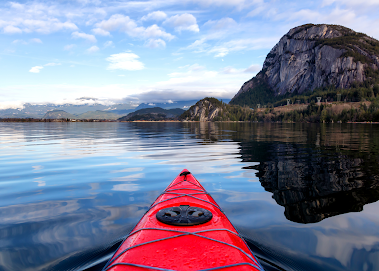 |
| View of the Stawamus Chief from the water |
Nestled at the head of Howe Sound and surrounded by mountains, Squamish is cradled in natural beauty as only a West Coast community can be.
Growing in fame as the Outdoor Recreation Capital of Canada, visitors enjoy the breathtaking scenery while hiking, climbing, kicking back or participating in the growing number of attractions to explore in this wilderness community.
The area is home to the Squamish First Nation, the Sk̲wx̲wú7mesh Úxumixw and Lil’wat7ul Nations, both descendants of the Coast Salish First Nations.
The area is home to the Squamish First Nation, the Sk̲wx̲wú7mesh Úxumixw and Lil’wat7ul Nations, both descendants of the Coast Salish First Nations.
Before Europeans came to the Squamish Valley, the area was inhabited by the local First Nations. One of the first contact they had with European outsiders was in 1792, when Captain George Vancouver came to Squamish to trade near the residential area of Brackendale. At the time, the territory of the Sk̲wx̲wú7mesh Úxumixw Nation and Lil’wat7ul Nation extended from present day Greater Vancouver, past Squamish and Brackendale all the way to Gibson's landing, some 6732 square kilometers.
During the 1850s gold miners came in search of gold and an easier gold route to the Interior. Settlers began arriving in the area in 1889, with the majority of them being farmers relocating to the Squamish Valley. The first school was built in 1893 and the first hotel opened in 1902, on the old dock in Squamish.
Squamish means Mother of the Wind in Coast Salish, an homage to the winds that rise from the north before noon and blow steadily until dusk, making Squamish a top wind surfing destination and host to the annual PRO-AM sailboard races. That same wind blows in a fury down the fjord as (outflow) katabatic winds that bring with them trees and other debris that can cripple a watercraft. I have been hit by them on more than one occasion sailing from Vancouver to Bowen Island.
The impressive cliff you see in the image above is the Stawamus Chief. It began life as a pool of molten magma deep in the Earth's belly. It rose to the surface and began to cool sometime in the early Cretaceous, 100 million years ago, leaving behind the second largest free standing piece of granite in the world at a staggering 2,297 feet — or over 700 metres.
It has made Squamish one of the top rock climbing destinations in North America and been the source of inspiration for climbing legends like Peter Croft, Hamish Fraser and Greg Foweraker.
This majestic peak is said to have been one of the last areas of dry ground during a time of tremendous flooding in the Squamish area. Many cultures have a flood myth in their oral history and the Sk̲wx̲wú7mesh Úxumixw are no exception. They tell of a time when all the world save the highest peaks were submerged and only one of their nation survived. Warned in a vision, a fierce and clever warrior escaped to safety atop Mount Chuckigh, now called Mount Garibaldi, as the flood waters rose.
 |
| An Eagle soars near Squamish, BC |
The glory days of its violent past are now peaceful but its history tells the tale of colliding crustal plates, earthquakes and volcanic activity not so long ago.
After the flood, Eagle, a spiritual messenger from the Creator, came to him with a gift of salmon and told him that the world below was again hospitable and ready for his return. He climbed down the mountain to find his village covered by a layer of silt.
All his people had perished, but his gods gave him another gift, a second survivor of the flood, a beautiful woman who became his wife.
The couple shared the story of the Eagle's gift. Today, eagle feathers are given as sacred gifts to symbolize courage, wisdom and honour the commitment of relationships as eagles mate for life.
If you look to the local mountains, you can see another peak that holds the nesting place of another legend. The Sk̲wx̲wú7mesh Úxumixw and Lil’wat7ul Nations share the story of Thunderbird, a supernatural being that causes thunder and lightning, who roosts atop Black Tusk, a volcanic mountain in the local range.
If you are in Squamish in on the first Sunday after New Year's day, you can honour the eagles by participating in the Annual Brackendale Winter Eagle Count.
If you happen down the Sea to Sky Highway anytime between May to October, stop by the BC Museum of Mining or Squamish Adventure Centre. Both offer wonderful educational programs and cultural insights of the area with additional programs being planned..
The Squamish Lil̓wat Cultural Centre and the Whistler Centre for Sustainably support local Indigenous tourism programs with the hope of igniting indigenous-based social enterprises from communities in the Fraser Valley all the way to Lillooet.
If you happen down the Sea to Sky Highway anytime between May to October, stop by the BC Museum of Mining or Squamish Adventure Centre. Both offer wonderful educational programs and cultural insights of the area with additional programs being planned..
The Squamish Lil̓wat Cultural Centre and the Whistler Centre for Sustainably support local Indigenous tourism programs with the hope of igniting indigenous-based social enterprises from communities in the Fraser Valley all the way to Lillooet.
Nch’ḵay̓ (Mt. Garibaldi) / Sxeltskwu7 (Ice Cap Peak on the Ashlu/Elaho divide) / Xwsa7k (Mount Baker in Washington State)
